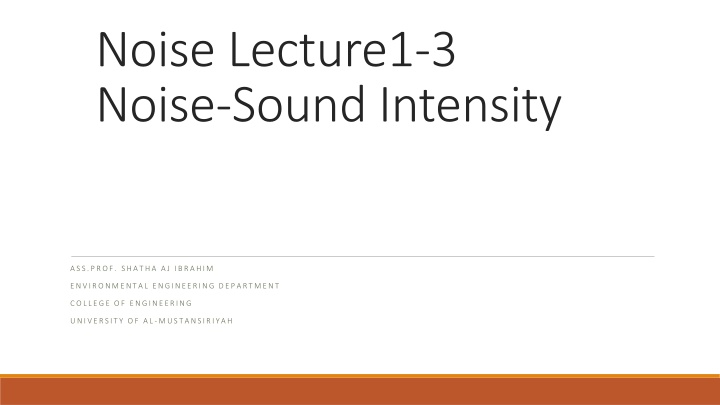
Sound Intensity, Power, and Decibels in Environmental Engineering
Learn about sound intensity, power, and decibels in environmental engineering, including the concept of acoustic impedance, calculation equations, and common sound levels. Explore the relationship between sound levels, acoustic impedance, and material density.
Download Presentation

Please find below an Image/Link to download the presentation.
The content on the website is provided AS IS for your information and personal use only. It may not be sold, licensed, or shared on other websites without obtaining consent from the author. If you encounter any issues during the download, it is possible that the publisher has removed the file from their server.
You are allowed to download the files provided on this website for personal or commercial use, subject to the condition that they are used lawfully. All files are the property of their respective owners.
The content on the website is provided AS IS for your information and personal use only. It may not be sold, licensed, or shared on other websites without obtaining consent from the author.
E N D
Presentation Transcript
Noise Lecture1-3 Noise-Sound Intensity ASS.PROF. SHATHA AJ IBRAHIM ENVIRONMENTAL ENGINEERING DEPARTMENT COLLEGE OF ENGINEERING UNIVERSITY OF AL -MUSTANSIRIYAH
1.6 Sound Intensity and Sound Power The sound power flowing per unit area, in a given direction, measured over an area perpendicular to the direction of flow, its units are W/m2, Symbolically, the sound intensity is then I=W/A Where I= sound intensity (W/m2) W= acoustical sound power of the source (W) A= surface area (m2), for a point source, the areas over which sound power distributes are concentric spheres with an increasing radius and therefore an increasing area of 4 r^2 also, it can used the equation below to calculate Sound Intensity: I=P^2/ c Where P= mean square sound pressure (Pa2) = density of medium (kg/m3) c= speed of sound (m/sec)
the term (c) is known as the acoustic impedance ( is a basically a measure of the resistance a fluid or material medium gives to the propagating of sound waves, it is the product of the speed of sound in the medium and its density), in the air c =429 rayls (rayl =kg/m2.sec). Material Density (kgm-3) Speed (ms-1) of sound Acoustic (kgm-2s-1x106) impedance Air 1.3 330 0.000429 Water 1000 1450 1.50 Bone (average) 1500 4000 6.00
1.7 What is a decibel? The decibel (dB) is used to measure sound level, but it is also widely used in electronics, signals and communication. The dB is a logarithmic way of describing a ratio. The ratio may be power, sound pressure, voltage or intensity or several other things. The reference value in sound levels corresponds to minimum audible sound to the average human ear at 1000Hz.
1.8 Sound Pressure Level, Sound Intensity Level, Sound Power Level Sound Pressure level measured on a dB scale: SPL=10 log (P_rms/P_o )^2 =20 log P_rms/P_o Where SPL= Sound Pressure Level (dB) Prms= Root mean square sound pressure (Pa) Po= Reference value (20 10-6 Pa) SIL=10 log I/I_o Where SIL= Sound Intensity Level (dB) I = Sound intensity (W/m2) Io= Reference value (10-12 W/m2)
SWL=10 logW/Wo Where SWL=Sound Power Level (dB) W= Sound power (W) Wo= Reference value (10-12 W) 1.9 Some Common Sounds Table below illustrate sound pressure and sound pressure level for some common sound .
Notes: A change in level of <1 dB is not predictable A change in level of 3 dB is just predictable A change in level of 5 dB is clearly predictable A change in level of 10 dB is twice as load Zero dB level does not mean an absence of sound , it merely implies that the level is equal to the reference value. 1.10 Addition of Sound Pressure Level and Sound Power Level In most industrial environments, sound is emitted from than one source or at different frequencies, so, the cumulative or overall or total SPL can be calculated from this equation: SPL _t=10 log _(i=1)^n 10 ^( SPL _i 10) When many sources have the same SPL, this equation can be used: Increase in dB level =10 log (N) Where N=Number of sources and total SWL can be calculated by: SWL _t=10 log _(i=1)^n 10 ^( SWL _i 10)















